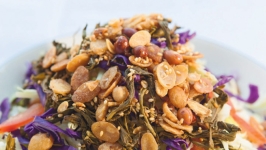Tapestry Suppers: A Culinary Exchange of Stories, Cultures and Food
Throughout this past year, hosts of Tapestry Suppers, special gatherings that bring people together to experience and connect with different cultures, have been welcoming dozens of strangers to their homes. The hosts prepare sumptuous homemade meals and set beautiful tables decorated with garden flowers and topped with dishes from their culture.
Depending on the Tapestry Supper, one might find dry-mango spiced chicken, apple cabbage slaw with black mustard seeds, pomodori ripieni con riso, Persian yogurt, laphet thoke, or stone fruit salad with spiced maple syrup and whipped cream. Each supper showcases the cuisine and culture of the host, which could mean it’s an Italian dinner al fresco, or a Burmese repast with complexly flavored curries and bright, colorful condiments.
The idea for Tapestry Suppers came from Danielle Tsi, a Bay Area food photographer. Sitting down at a busy Sunnyvale coffee shop recently, she explained how the idea for Tapestry Suppers was a form of therapy.
“These gatherings are therapy for the disconnect, isolation and polarization that is so endemic today. Most social interactions take place online. We are forgetting how to relate to each other with the depth of stories, emotions and experiences that we carry with us.” Leaning forward in her chair, she added, “It’s time to rebalance this dynamic by creating opportunities for in-person gatherings, and at Tapestry Suppers, we’ve chosen the meal as our preferred platform for building community.”
The inaugural Tapestry Supper was held in March at the home of Thoa Van Seventer, who fled Vietnam with her family decades ago and now calls the Bay Area home. Thoa wanted to host a Tapestry Supper because, as she points out, “Exotic food makes people curious about other races, other cultures and brings them closer to each other. It helps us become more open-minded, more tolerant, more generous to people who are different from us.”
The formula is simple: Hosts volunteer their time, homes and culinary skills. Danielle and her team help with planning, marketing and logistics. The host selects a charity that will receive proceeds from tickets guests purchase to attend the dinner. The ticket price covers supplies for the meal such as food, beverages and renting tables. Everything raised over the cost of the event is donated. The contributions have already resulted in thousands of dollars being donated this year to the International Rescue Committee, Mercy Corps and Immigration Equality.
Tapestry Supper guests get the chance to experience the hospitality of someone from another culture, to taste new food, to share conversation and stories, but mostly, to build community. Elaine Baskin, who has attended several suppers, explains it in simple terms: “Conversation over meals can be very relaxing and is a good time to be open and receptive. Discussing the different culture that surrounds the food helps me understand that culture and the people who were raised in it, and appreciate what is different and good and what we all have in common.”
These suppers are important to the Silicon Valley community. They offer guests a chance to learn; perhaps even more importantly, they offer hosts a chance to share their stories, their experiences, their perspective and their cuisine. Mojdeh Zahiraslamzadeh, the hostess of a recent Persian Tapestry Supper, notes, “Being an immigrant is hard, especially at first when one moves to a strange land. It takes time to grow roots and find a sense of identity. It takes time to find a sense of belonging.”
Danielle understands the immigrant experience first-hand. For a long time, she says, she was “culinarily homesick.” Growing up in Singapore, she was surrounded by international flavors in an intersection of cultures and cuisines. Food was part of her social genetics; cooking, consuming and discussing food was part of what it meant to be a Singaporean. Her upbringing instilled in her a strong belief that food has the power to bring people together.
“I’ve found that an appreciation of food is one of the most effective ways to learn about a culture—it’s an easy bridge of connection,” she says. Danielle believes that sharing a meal is a lot more powerful than we realize. “Eating as part of a collective elevates that act of nourishment by helping us bond over a common experience, whether it’s tacos or Thanksgiving dinner.”
“Besides,” she adds with a grin, “food simply tastes more delicious when enjoyed with others.”
For a foodie community like Silicon Valley, this is another crucial aspect of Tapestry Suppers: The food is delicious. April Chou, who hosted the Burmese supper and has attended several others, explains: “The food is better than what you get at restaurants because it is home-cooked, in a traditional style and prepared with lots of time, commitment and love.”
For the Persian gathering, Mojdeh prepared sabzi polo (herbed rice), shirin polo (jeweled rice), khoresht e bademjan (eggplant stew), kashk e bademjan (eggplant dip), khoresht e ghormeh sabzi (an herbed stew) and plenty of Persian sweet treats. She learned to cook from her mother and now cooks all of these recipes from memory. She says that Persian food “is really about pouring your love into your food so that the people you share it with feel that love.”
Amy Wilkinson, who also attended the Burmese event, remembers her hostess, April, telling the story of how she tried to prepare a coconut dessert but she couldn’t remember how to make it. She had always relied on her mother, grandmother and aunts to give her directions. So she had to get input from family members and others in the community to piece together the recipe.
“All of the guests related completely, as many folks had the same experience with their family recipes,” says Amy. “This is the perfect example of why these gatherings are successful—the transmission of culture, the need for everyone to be involved in passing down the family history, and the way everyone at the event resonated with this story and connected with each other. It was a great moment.”
Danielle sees the Tapestry Suppers as a movement. It’s a chance to be charitable, to share culture and cuisine and to have a great meal, but it’s also an occasion to build a stronger and more connected community. She wants everyone to feel invited to supper—to attend a supper, host a supper or to start your own Tapestry Supper group. There are endless opportunities to bring people together over food. As April says, “Food is love and sharing. It touches us in a number of ways—physically, mentally, emotionally. We learn about culture through food, yet on a basic level, it is all love. Rice may be cooked various ways, eggplants may be prepared differently with different spices, but at the end of the day we are all sharing ourselves with friends.”
To learn more about upcoming events and how to host your own supper, visit TapestrySuppers.org.





